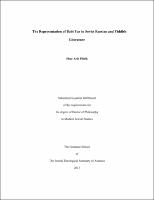Please use this identifier to cite or link to this item:
https://hdl.handle.net/20.500.12202/7112| Title: | The Representation of Babi Yar in Soviet Russian and Yiddish Literature |
| Authors: | PIlnik, Shay Arie Roskies, David |
| Keywords: | Soviet Russian literature YIddish literature Babi Yar PhD dissertation Holocaust genocide Slavic literature Russian history Judaic studies Holocaust studies Language, literature and linguistics social sciences memory |
| Issue Date: | Jun-2013 |
| Publisher: | ProQuest Dissertations & Theses Global |
| Citation: | Pilnik, Shay Arie. 2013. "The Representation of Babi Yar in Soviet Russian and Yiddish Literature." Order No. 3559036, The Jewish Theological Seminary of America. https://yulib002.mc.yu.edu:8443/login?url=https://www.proquest.com/dissertations-theses/representation-babi-yar-soviet-russian-yiddish/docview/1353104917/se-2?accountid=15178 |
| Series/Report no.: | ProQuest Dissertations & Theses Global;Order No. 3559036 |
| Abstract: | This dissertation is dedicated to the literary representation of the memory of Babi Yar, the ravine on the outskirts of Kiev where over 100,000 people, primarily Jews, were murdered during World War II. During the Cold War there was a tendency among scholars in the West to underline the role of Babi Yar as a battleground between the Soviet state that wished to erase the site from the face of the earth, and individual Soviet dissidents, who protested these suppressive measures. By focusing on Soviet literature, the major arena where the memory of Babi Yar crystalized, I qualify this tendency and offer a new approach to this commemorative process. By including the analysis of works in both Russian and Yiddish, I delineate the commemoration of Babi Yar as a process that entailed a constant negotiation between Moscow and its writers. My investigation of the works written on Babi Yar in these two languages positions the site, not only as an ideological middle ground between the state and its writers, but also between the master narrative of the Great Patriotic War (cultivated by Moscow in the post-Stalin years as the regime's new legitimating myth) and that of the Holocaust of European Jewry (which the Soviet regime, by contrast, tended to gloss over). Recognizing the common denominators that underlie the representation of Babi Yar in Soviet literature, I also dwell on the crucial differences between the two spheres. In Part I, dedicated to the works of the Russian writers Viktor Nekrasov, Yevgeny Yevtushenko and Anatoly Kuznetsov as well as the composer Dmitry Shostakovich, I illustrate Babi Yar's role as a trope of "permitted dissent," i.e. as a theme the Soviet intelligentsia espoused in order to broaden the boundaries of the permissible in Soviet culture. In Part II, by contrast, exploring works dedicated to Babi Yar in Yiddish written by Itsik Kipnis, Shike Driz, Motl Talalayevsky, Dore Khaykine and Shloyme Cherniavsky, I illustrate the minor role that Babi Yar played in this sphere, a theme that remained largely suppressed. |
| Description: | Doctoral dissertation / PhD |
| URI: | https://yulib002.mc.yu.edu:8443/login?url=https://www.proquest.com/dissertations-theses/representation-babi-yar-soviet-russian-yiddish/docview/1353104917/se-2?accountid=15178 https://hdl.handle.net/20.500.12202/7112 |
| Appears in Collections: | The Emil A. and Jenny Fish Center for Holocaust and Genocide Studies -- Faculty Publications |
Files in This Item:
| File | Description | Size | Format | |
|---|---|---|---|---|
| Pilnik 2013 Dissertation Babi Yar JTS OA.pdf | 1.66 MB | Adobe PDF |  View/Open |
This item is licensed under a Creative Commons License

